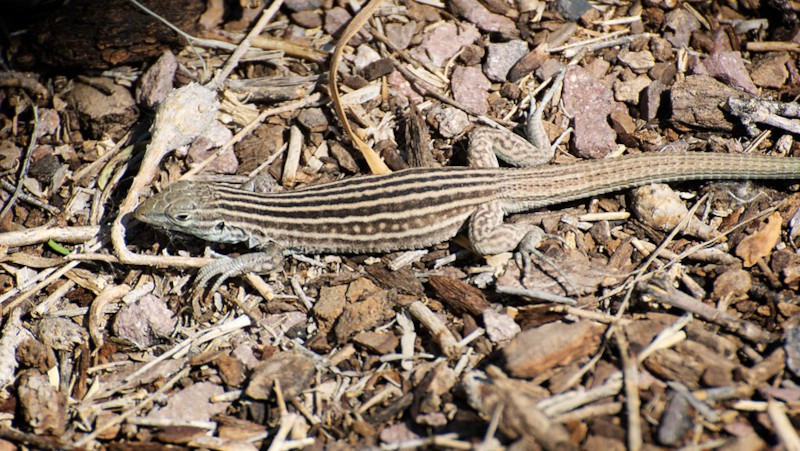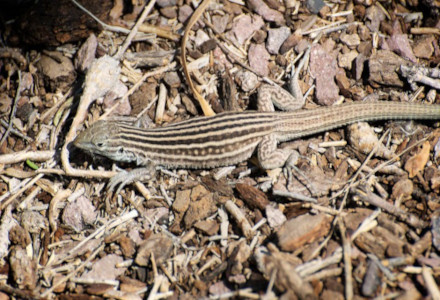
Photographer: Roger Shaw
CC License: https://bit.ly/3i4tdZM
Leaping Lesbian Lizard Facts
- Somewhat uniquely, the Leaping Lesbian Lizard serves as the popular name for a particular New Mexico Whiptail Lizard. What sets it apart, however, is the fact that it was produced through the inter-breeding of two distinct native species of lizard.
- Amazingly, this astonishing lizard resulted from the mixing of the Little Striped Whiptail and the Western Whiptail. The hybridization of these species produces sterile males, however. But, the resourcefulness of Nature did not stop there.
- That’s because the species achieved parthenogenesis, a type of asexual reproduction. This allows the resulting all-female population to reproduce. The unusual lizard, therefore, actually evolved into a separate species capable of reproduction.
- In fact, this combination of inter-species hybridization and parthenogenesis isn’t unique. It also exists in other species within the animal kingdom. That’s due to the fact that the process exists as a reproductive strategy in other species of whiptail lizard.
- The Leaping Lesbian Lizard also holds yet another distinction. This one, however, has nothing to do with any physical aspect of the creature. That’s because this phenomenal reptile currently represents the official state reptile of the state of New Mexico.
Related Articles
Draco Volans Tuatara Thorny Dragon
Photo Credit: Lon&Queta
CC License: http://bit.ly/2OUHszC
Leaping Lesbian Lizard Physical Description
Perhaps most notably, the amazing Leaping Lesbian Lizard, regardless of other attributes, constitutes a small-to-moderate sized lizard. That occurs due to the fact that the majority of individuals attain a total length measuring between 6.5 – 9.1 in (16.5 – 23 cm).
Quite obviously, sexual dimorphism does not appear in this species, as it does in many related creatures, though. Among most specimens, its natural coloring typically presents as an overall brown or black. However, seven pale yellow stripes also from head to tail.
Numerous light spots also often occur between the head-to-tail stripes. The majority of individuals also have a white or pale blue underside, with a blue or blue-green colored throat. The body of the Leaping Lesbian Lizard additionally develops a distinctive shape.
That construction appears as distinctly slender, while the tail of the awesome reptile grows comparatively long. In fact, this particular shape, in combination with its coloring pattern, further represents an evolutionary adaptation for camouflage in its native habitat.
- Kingdom: Animalia
- Phylum: Chordata
- Class: Reptilia
- Order: Squamata
- Family: Telidae
- Genus: Cnemidophorus
- Species: C. neomexicanus
Leaping Lesbian Lizard Behavior
Like most other whiptail lizards, the Leaping Lesbian Lizard also evolved as diurnal. It’s thus far more active in the daylight hours. It also evolved as entirely insectivorous in nature. It remains wary, energetic, and fast moving, frequently darting for cover if approached.
Its reproductive methods, however, clearly and distinctly separate the animal from most related types of lizards. When this reptile reproduces, the mother-to-be lays up to four unfertilized eggs. This action most commonly occurs in the mid-summer part of the year.
These precious few eggs laid then typically hatch approximately eight weeks later. Despite reproducing asexually, and being an all-female species, the Leaping Lesbian Lizard still engages in mating behavior with other females of its own species, as its name also implies.
Interestingly, a common theory among many researchers suggests a logical purpose for this. That theory proposes that this observed behavior helps to stimulate ovulation. This belief occur due to the observed fact that those who do not mate do not lay eggs.
Leaping Lesbian Lizard Distribution, Habitat, and Ecology
Not surprisingly, the fascinating Leaping Lesbian Lizard evolved as native to a particularly arid environment. This range likely comes as no surprise to some, though. That specific range includes the southern United States and also northern Mexico, in North America.
However, even within these two regions, the amazing Leaping Lesbian Lizard also has specific areas it chooses to inhabit. As a result, in the United States it only appears in New Mexico and Arizona. Meanwhile, in Mexico, the species only lives in the area of Chihuahua.
The New Mexico Whiptail Lizard, as it is also known, also lives in a rather wide variety of semi-arid habitats. These varied regions include grassland, rocky areas, shrubland, or mountainside woodlands, proving its adaptability. It’s truly a remarkable creation of Nature.
Species Sharing Its Range
Love Bug Texas Horned Lizard Volcano Rabbit
Check out our other articles on Breathtaking Asian Species, Komodo Dragon, Bloody Hell Pond, Hornet Robberfly, Ascension Island Parsley Fern, Galapagos Penguin, Ribbon Eel

